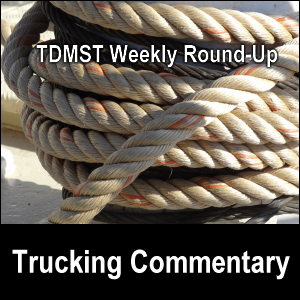This is the TDMST Weekly Round-Up of news affecting professional truck drivers, written by Vicki Simons for the week ending May 23, 2020.
We welcome your comments, thoughts and feedback on the items of your choice below.

1. Regarding contact tracing:
If you thought that cab-facing cameras were an invasion of privacy, then be prepared for an even larger potential invasion of privacy with 24/7 surveillance through any kind of “contact tracing” app, software or capability through ELDs.
What is “contact tracing”?
According to Wikipedia, “In public health, contact tracing is the process of identification of persons who may have come into contact with an infected person (“contacts”) and subsequent collection of further information about these contacts.”
Wikipedia also says, “Challenges with contact tracing can arise related to issues of privacy and confidentiality.”
First, I feel that you need to understand the scope and danger of this:
Quoting just two paragraphs from the National Vaccine Information Center’s Summary on OPPOSE H.R. 6666, the COVID–19 Testing, Reaching, And Contacting Everyone (TRACE) Act:
H.R. 6666 provides 100 billion dollars this year and unlimited federal funding in future years to create and operate a massive and likely unconstitutional surveillance, testing, and tracing enforcement system under the guise of “protecting” Americans against coronavirus.
H.R. 6666 is a federal funding bill. It proposes to create a surveillance infrastructure that can be used by the federal government, as well as local and state governments and private businesses, to require medical testing and tracking of all citizens in violation of fundamental civil liberties as set forth in the Bill of Rights, which include the first 10 amendments to the U.S. Constitution designed to protect individual rights and limit the power of the government.
There will probably be more about this from trucking publications in the future. For now, we read:
Fleet data offers contact tracing tool for Covid-19.
The opening paragraph of Can ELDs Help Track COVID-19 Cases? addresses tracking for the purposes of helping fleets “prevent the spread of COVID-19.”
This past Thursday night (May 21, 2020), I heard a medical doctor say that it is impossible to contain the coronavirus that leads to COVID-19.
So, the push for contact tracing and tracking is being done under the guise of safety, while in fact it is being done for other reasons.
I also have serious concerns about how contact tracing will work with:
- Health Insurance Portability and Accountability Act (HIPAA);
- which is often stated as “Health Information Privacy and Portability Act” (HIPPA).
Let me state it very plainly: I am 100% opposed to contact tracing by any means or for any reason.
We are human beings, not dogs, cats or other types of creatures that may be tagged or tracked.
We must oppose having our persons tracked or traced through our phones or RFID chip or any other device.
2. Regarding trucker pay:
According to this article, the ATA says that truck driver pay climbed in 2019.
Let me address a couple of things that the article stated:
- “U.S. fleets paid drivers nearly US$6,000 more, including bonuses, in 2019 than they did in 2017, according to a Driver Compensation Study conducted by the American Trucking Associations (ATA).”
- “Average pay for truckload national, irregular route solo van drivers climbed to roughly $58,000.”
First, notice that the comparison skipped 2018. So, that $6,000 has to span 2 years. More on that in a bit.
For up to 70 hours of work per week (that are captured on log books or ELDs),
for 52 weeks a year,
that comes to 3,640 hours.
Divide $58,000 by 3,640 hours to get $15.93 per hour.
For all that truckers do, I personally believe that truckers deserve much higher pay than that.
Moving on…
If we look at just this article, it appears as though the ATA would prefer that we keep our focus on short periods of history to make it look like truckers are making oh, so much money!
However, bear in mind that we documented here and here that in May 1977, truckers were earning $500 per week.
Using the handy-dandy CPI Inflation Calculator from the U.S. Bureau of Labor Statistics, let’s look to see what trucker pay should have been had wages kept up just with inflation from May 1977 to May 2019.
$500 per week in May 1977 has the same buying power as what amount of money in May 2019?
$2,123.48 per week or $110,420.96 per year!
Bear in mind, that number is simply keeping pace with inflation, not actually providing a raise.
Still, if truckers were earning that much money, there would be something to celebrate.
I’ll be very interested to see what the ATA will say about trucker pay in 2020, especially taking into account both the COVID-19 plandemic and the alleged broker price-gouging situation.
The news about company driver pay being up $6,000 in 2019 was also covered here.
3. Regarding broker transparency:
In a May 20, 2020, article, OOIDA’s Todd Spencer stated:
Brokers have been deliberately skirting federal transparency regulations for decades. We certainly don’t think exempting yourself from federal regulations is legal, but this is precisely what is happening. It has to stop.
A May 21, 2020, article stated that the Transportation Intermediaries Association [TIA], a freight brokers group, has “declared war on owner-operators” who have been asking questions about “what shippers paid brokers for the loads they hauled.”
Brokers are already required to make transaction details available to all parties, shipper and carrier alike. The rules have been in place for a long time, and for just as long brokers have found ways around them. … Now, many truckers reasonably want to know for certain whether or not they are being gouged by brokers.
OOIDA suggested a simple solution to lawmakers: make brokers obey the rules. Forbid the forfeiture of your right and require brokers to specifically reveal their margins in the paperwork after each load. OOIDA has since made a formal appeal to the FMCSA to use the enforcement power they already have. …
TIA released whatever reasons they could conjure against transparency, whether the reasons made sense or not. …
[Why?] Money. What else?
That money can only be in one place – the margins between what shippers pay brokers and what brokers pay carriers, margins the TIA desperately wants us not to see.
Many other articles have been written about this issue, including:
- Head of Largest Broker Group Weighs in on DOJ Investigation, “They Won’t Find Anything”
- Truckers Emerge From White House Meeting Declaring “We Won a Battle”
- DOJ Begins Interviewing Truckers in Probe of Alleged Freight Broker Collusion
- D.C. Rally Leaders to Meet at White House With Top Trump Administration Officials
- OOIDA Petitions FMCSA to Crack Down on Freight Brokers
- President Trump Slams Freight Brokers AGAIN in Explosive New Comments
- OOIDA Calls on Congress For Emergency Action on Broker Reform, Driver Pay, Truck Parking
- Polite protesting truckers get results in Washington
- White House meeting produces ‘sort of a victory’ for jubilant protesters
- End in sight as protesters prepare for White House meeting
- News roundup, May 20: OOIDA calls on DOT for increased broker transparency
- Truckers finally got that White House meeting. Here’s what happened.
- Truckers ask FMCSA for ‘immediate action’ against unscrupulous brokers
4. Regarding trucking conditions:
According to this article, trucking conditions “nosedived” in March.
Data collected “during the first 36 days of the federal declaration of emergency due to… COVID-19” found… “found a 20% drop in the average distance driven and several, unsafe, changes in driving behavior,” according to a May 19, 2020, article.
Articles published this week addressed truck tonnage being down in April, including these:
- April Truck Tonnage Takes a Dive, 11.3% Below Last Year; and
- American Trucking Associations truck tonnage index plunged 12.2% in April(a)
A May 19, 2020, article says that “for-hire truck tonnage” in April plummeted the “most in 26 years.”
Meanwhile, we read: April’s preliminary net trailer orders hit all-time low volume.
An ELD provider laid off 18% of their workers.
On at least a somewhat positive note:
- Spot rates rise as number of available trucks drops
- Spot freight volume ticks up amid improving market conditions
- Truck rates firm up as capacity plunges 17.5%
- Auto haulers may soon be on the upswing
- Carriers report optimism for rebound in the coming month
5. Regarding trucking company bankruptcies:
On May 18, 2020, U.S. trucking giant Comcar [filed] for bankruptcy.
Comcar Industries owned 5 transportation subsidiaries, each of which is being sold due to the company’s debt exceeding their assets.
More about Comcar’s bankruptcy was written:
Meanwhile, we read that “DM World Transportation LLC of Longwood, Florida, has filed for Chapter 11 bankruptcy protection.”
6. Regarding getting past COVID-19:
In a May 19, 2020, article, How to Get Trucking Past the Coronavirus Pandemic, there are “10 key resources for understanding the compliance landscape in our new era of COVID-19 and beyond.”
7. Regarding artificial intelligence:
From 5 Ways AI Can Help Trucking, I was particularly interested in:
- “Make Predictive Maintenance a Reality” and
- “Improve Driver Productivity.”
Under the latter, we read:
- “many of the AI technologies that are being used to develop autonomous trucks are also being used today in advanced driver assistance systems”; and
- “Schneider uses AI for more accurate estimated times of arrival, through something it calls ETAI.”
In the article, “Dig Deeper: Artificial Intelligence and Trucking,” I was glad to read the admission: “There are some tasks that artificial intelligence is really good at – and some that it’s not,” more detail of which was covered separately.
FWIW, in a linked Artificial Intelligence glossary, we read:
“Artificial Intelligence: Computers capable of doing human-like tasks: decision-making, object classification and detection, speech recognition and translation.”
Yet, I stress that machines are incapable of thinking like a human.
8. Regarding Hours of Service regulations:
In the wake of the announcement about the Hours of Service regulations change, we read:
- that they are effective in September;
- truckers sounded off about the rules changes;
- opinions about the HOS rules change were captured in a poll
- Overdrive readers offer mixed takes on new hours of service
Did you submit your comments about the HOS exemption request from Pronto.ai?
I did!
Here’s what OOIDA said: it would put drivers at risk.
Meanwhile the FMCSA granted an HOS exemption, but denied another.
9. Regarding CVSA:
According to articles here and here, the 2020 Operation Safe Driver Week will proceed on July 12-18 with a focus on speeding.
10. Regarding cargo theft and cyber threats:
Be vigilant to protect what needs to be protected:
- Good news: Less traffic. Bad news: More cargo thefts;
- Pharmaceutical supply chains at risk of emerging cyber threats.
11. Regarding illegal moves:
Articles written here, here and here addressed how a Canadian trucker was “busted” at the U.S. Canada border for having 134 pounds of cocaine — valued at $3 million.
The trucker was arrested and the tractor-trailer was seized.
Don’t ever attempt to transport “dangerous narcotics” in a big truck.
Meanwhile we read that the “U.S. Border Patrol [foiled] three human-smuggling attempts in a single day, two involving tractor-trailers.”
Human beings are not freight or cargo.
Those who wish to enter this country need to do so legally.
12. Regarding painful-to-watch trucker videos:
A log truck driver attempted to make a sharp right turn, got his right rear trailer wheels stuck in the depression and ended up losing part of his load across the road.
Remember all of that serpentine training you underwent during truck driver training?
Watch your turning radius.
After a trucker “forgot” to secure a forklift in the back of his trailer and failed to close one of his trailer’s doors, the inevitable happened as the trucker was driving: the forklift fell out!
Secure your load, close both trailer doors, and lock them.
A dump truck driver “forgot” to lower the bed on his truck and collided with a bridge in Milwaukee, Wisconsin.
Ouch!
If you drive a truck with a bed that can be raised and lowered, don’t pull out without lowering the bed.
Make sure you can see in your mirrors that the bed stays in the “down” position the entire time you’re driving — and that you’re glancing at your mirrors every 8-10 seconds or so.
That way, in case a mechanical malfunction causes the bed to rise en route, you’ll know about it before you hit something.
13. Regarding compliance assessments and reviews:
Be aware of compliance assessments and reviews may be conducted remotely, with no on-site visit:
- FMCSA issues guidance on conducting compliance assessments during COVID-19 crisis
- News roundup, May 21: FMCSA moving to remote compliance reviews during pandemic
- Compliance reviews to be conducted remotely during pandemic
14. Regarding AB5:
Did you think the situation with AB5 in California had gone away?
According to a May 19, 2020, article:
There were six separate amicus briefs filed to the court last week in support of [the California Trucking Association’s] lawsuit. An amicus brief is a legal document filed in appellate court cases … by parties that are not part of the case with strong interest in the subject matter. Those who filed briefs were:
- Owner-Operator Independent Drivers Association
- American Trucking Associations
- Western States Trucking Association
- [and the others named].
More was written about AB5 here.
15. Congratulations!
Our heartiest congratulations go to Stephen Dixon who has driven for National Carriers Inc. (NCI) since 2008 and was “named 2019 Driver of the Year… largely because of his willingness to go out of his way to help fellow drivers.”
According to the article, Dixon is a “Veteran driver who ‘always gives 110%.'”
Thanks for your helpful attitude, Stephen!
My husband Mike and I wish you — and all professional truck drivers — safe travels and lots of money saving opportunities on the road.
Return from TDMST Weekly Round-Up: 2020.05.23 to our TDMST Weekly Round-Up Trucking Commentary or our Truck Drivers Money Saving Tips home page.
References:
a. www.thetrucker.com/trucking-news/uncategorized/american-trucking-associations-truck-tonnage-index-plunged-122-in-april/ (no longer online)







